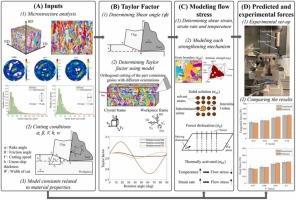增材制造金属零件的加工力学:材料表征和本构建模
IF 11.1
1区 工程技术
Q1 ENGINEERING, MANUFACTURING
引用次数: 0
摘要
增材制造(AM)可以通过逐层工艺生产复杂的定制部件。然而,高表面粗糙度和几何畸变往往需要后处理,加工是最广泛使用的方法。因此,了解增材制造零件的可加工性对于选择合适的工具和加工参数至关重要。这需要深入了解材料的微观结构和力学行为,这些都受到AM工艺条件的显著影响。增材制造工艺固有的快速凝固和陡峭的热梯度导致了不同的晶体结构和柱状晶粒生长,这影响了材料在加工过程中的响应。由于文献中不一致的实验结果,有必要进行微观结构的本构建模。本研究提出了一个综合的本构模型来预测正交切削过程中的流动应力和切削力,其中包括热激活、固溶、晶格阻力、晶界影响和森林位错相互作用等关键强化机制。采用激光粉末床熔融(LPBF)技术制备了广泛应用于关键工业应用的AM Inconel 718。利用电子背散射衍射(EBSD)和能量色散x射线能谱(EDS)对其微观结构特征和溶质原子浓度进行了表征,为本构模型提供了输入。通过不同切削条件下的正交切削实验对模型进行了验证。用测功机测量切削力,通过扫描电子显微镜(SEM)检查切屑。该模型预测的流动应力和切削力在实验值的10 %以内。此外,它还可以对每种强化机制的贡献进行定量评估,从而深入了解它们对am制造零件的加工行为的个别影响。本文章由计算机程序翻译,如有差异,请以英文原文为准。

Machining mechanics of additively manufactured metallic parts: Material characterization and constitutive modeling
Additive manufacturing (AM) enables the production of complex, customized parts through its layer-by-layer process. However, high surface roughness and geometrical distortions often necessitate post-processing, with machining being the most widely used method. Therefore, understanding the machinability of AM parts is essential for selecting appropriate tooling and machining parameters. This requires insight into the material’s microstructure and mechanical behavior, which are significantly influenced by AM process conditions. Rapid solidification and steep thermal gradients inherent to AM processes result in distinct crystallographic textures and columnar grain growth, which affect the material’s response during machining. Due to inconsistent experimental findings in the literature, there is a need for microstructure-informed constitutive modeling. This study presents a comprehensive constitutive model to predict flow stress and cutting forces during orthogonal cutting, incorporating key strengthening mechanisms: thermal activation, solid solution, lattice resistance, grain boundary influence, and forest dislocation interactions. AM Inconel 718 which is widely used in critical industrial applications was fabricated using laser powder bed fusion (LPBF). Microstructural features and solute atom concentrations were characterized using electron backscatter diffraction (EBSD) and energy-dispersive X-ray spectroscopy (EDS), providing input for the constitutive model. Model validation was performed through orthogonal cutting experiments under various cutting conditions. Cutting forces were measured using a dynamometer, and chips were examined via scanning electron microscopy (SEM). The model predicts flow stress and cutting forces within 10 % of experimental values. Moreover, it enables a quantitative evaluation of each strengthening mechanism’s contribution, providing insight into their individual effects on the machining behavior of AM-fabricated parts.
求助全文
通过发布文献求助,成功后即可免费获取论文全文。
去求助
来源期刊

Additive manufacturing
Materials Science-General Materials Science
CiteScore
19.80
自引率
12.70%
发文量
648
审稿时长
35 days
期刊介绍:
Additive Manufacturing stands as a peer-reviewed journal dedicated to delivering high-quality research papers and reviews in the field of additive manufacturing, serving both academia and industry leaders. The journal's objective is to recognize the innovative essence of additive manufacturing and its diverse applications, providing a comprehensive overview of current developments and future prospects.
The transformative potential of additive manufacturing technologies in product design and manufacturing is poised to disrupt traditional approaches. In response to this paradigm shift, a distinctive and comprehensive publication outlet was essential. Additive Manufacturing fulfills this need, offering a platform for engineers, materials scientists, and practitioners across academia and various industries to document and share innovations in these evolving technologies.
 求助内容:
求助内容: 应助结果提醒方式:
应助结果提醒方式:


